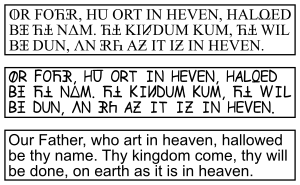Unifon
Unifon is a Latin-based phonemic orthography for English designed in the mid-1950s by Dr. John R. Malone, a Chicago economist and newspaper equipment consultant.

It was developed into a teaching aid to help children acquire reading and writing skills. Like the pronunciation key in a dictionary, Unifon matches each of the sounds of spoken English with a single symbol. The method was tested in Chicago, Indianapolis, and elsewhere during the 1960s and 1970s, but no statistical analysis of the outcome was ever published in an academic journal. Interest by educators has been limited, but a community of enthusiasts continues to publicize the scheme and advocate for its adoption.[1]
Alphabet

The Unifon alphabet contains 40 glyphs, intended to represent the 40 most important sounds of the English language. Although the set of sounds has remained the same, several of the symbols have been modified over the years, making "Modern Unifon" slightly different from "Old Unifon." The Unifon alphabet: A Δ Ʌ B Ȼ D E ƎE ƎR F G H ± J K L M N |/𝖩 O 𐍉 ⵀ ꐎ ꐎ P R S $ T 𝈥̄ Ћ U ⩌ ⩃ V W Z Y Ƶ[2][3]
Unifon letters unified with existing characters. Of the 66 letters used in the various Unifon alphabets, 43 of them—about two-thirds—can be unified with existing letters. Note that none of the small-cap letters are encoded modifier letters: they are small-caps styled forms of ordinary small letters.
A [æ], Ʌ [ɒ], B [b], C [s], Ȼ [tʃ], Ↄ [tʃ], D [d], E [ɛ], Ǝ [ə], F [f], G [ɡ], H [h], J [dʒ], K [k], L [l], M [m], N [n], O [ɔ], Ø [ʊ], P [p], R [r], S [s], T [t], U [ʌ], V [v], W [w], X [x], Y [j], Ƶ [ʒ]
History
Under a contract with the Bendix Corporation, Malone created the alphabet as part of a larger project. When the International Air Transport Association selected English as the language of international airline communications in 1957, the market that Bendix had foreseen for Unifon ceased to exist, and his contract was terminated. According to Malone, Unifon surfaced again when his son, then in kindergarten, complained that he could still not read. Malone recovered the alphabet to teach his son.[4]
Beginning before 1960 and continuing into the 1980s, Margaret S. Ratz used Unifon to teach first-graders at Principia College in Elsah, Illinois.[5] By the summer of 1960, the ABC-TV affiliate station in Chicago produced a 90-minute program in which Ratz taught three children how to read, in "17 hours with cookies and milk," as Malone described it. In a presentation to parents and teachers, Ratz said, "Some have called Unifon 'training wheels for reading', and that's what it really is. Unifon will be used for a few weeks, or perhaps a few months, but during this time your child will discover there is a great similarity between Unifon and what he sees on TV screens, in comics or road signs, and on cereal boxes. Soon he finds with amusement that he can read the 'old people's alphabet' as easily as he can read and write in Unifon."
During the following two years, Unifon gained national attention, with coverage from NBC's Today Show and CBS's On the Road with Charles Kuralt (in a segment called "The Day They Changed the Alphabet").
In 1981, Malone turned over the Unifon project to Dr. John M. Culkin, a media scholar who was a former Jesuit priest and Harvard School of Education graduate. Culkin wrote numerous articles about Unifon, including several in Science Digest.
In 2000, the Unifon web site, http://www.unifon.org, was created by Pat Katzenmaier with much input from linguist Steve Bett. It has served since then as a central point for organization of Unifon-related efforts.
Unifon for Native American languages
In the 1970s and 1980s, a systematic attempt was made to adapt Unifon as a spelling system for several Native American languages. The chief driving force behind this effort was Tom Parsons of Humboldt State University, who developed spelling schemes for Hupa, Yurok, Tolowa, and Karok, which were then improved by native scholars. In spite of skepticism from linguists, years of work went into teaching the schemes, and numerous publications were written using them. In the end, however, once Parsons left the university, the impetus faded; other spelling schemes are currently used for all of the languages.[6]
Character set support
The special non-ASCII characters used in the Unifon alphabet have been assigned code points in one of the Unicode Private Use Areas by the ConScript Unicode Registry.[7] Efforts are in progress to add the characters to the official Unicode character set.
References
- www.unifon.org
- http://www.unifon.org/pages/unifon-alphabet.html
- http://www.unicode.org/L2/L2012/12138-n4262-unifon.pdf
- Malone
- Ratz
- Hinton, pp 244-245
- "Unifon: U+E740 - U+E76F". ConScript Unicode Registry. Retrieved 2012-05-30.
Sources
- "The Unifon Alphabet". Retrieved August 31, 2008.
- Malone, John R. "Do we need a new alphabet?" (pdf). Retrieved August 31, 2008.
- Ratz, Margaret S. (1966). Unifon: A design for teaching reading. Western Pub. Educational Services.
- Hinton, Leanne (2001). "Ch 19. New Writing Systems". In Hinton L, Hale K (ed.). The Green Book of Language Revitalization in Practice: Toward a Sustainable World. Emerald Group Publishing. ISBN 978-0-12-349354-5.
- Culkin, John (1977). "The Alphubet". Media and Methods. 14: 58–61.